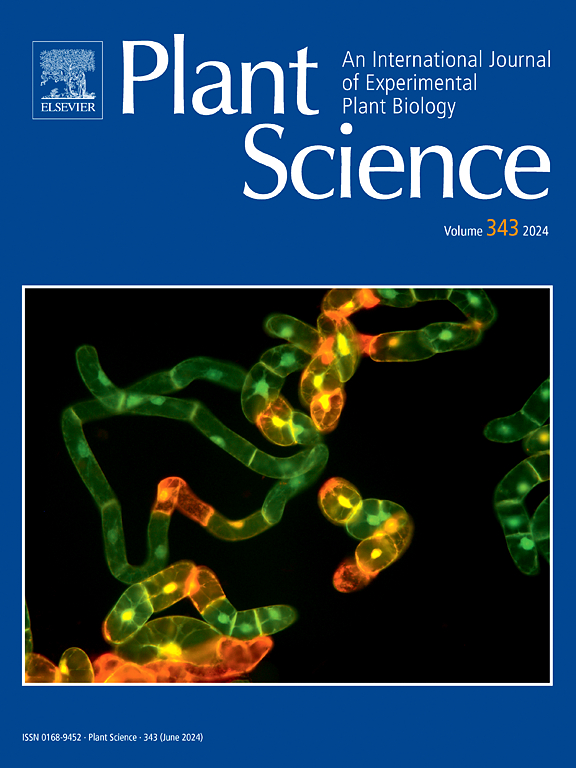干旱胁迫下CsAHL20负调控茶树表儿茶素的合成。
IF 4.2
2区 生物学
Q2 BIOCHEMISTRY & MOLECULAR BIOLOGY
引用次数: 0
摘要
儿茶素是茶叶有益化合物的一个组成部分,它们的生物合成对几种生物和非生物因素有关键反应。干旱是影响其生物合成的重要非生物因素之一。干旱胁迫下其生物合成的分子机制尚不清楚。一种转录因子AHL对干旱胁迫有强烈的响应,对其在茶树中的探索可以揭示儿茶素生物合成的干旱相关机制。茶树CsAHL基因家族鉴定和干旱转录组数据表明,该转录因子CsAHL20具有AT-hook基序,其位置为细胞核。该转录因子在干旱条件下显著上调,与儿茶素含量呈显著负相关。过表达CsAHL20后,表儿茶素生物合成关键基因CsANR显著下调,表儿茶素含量显著降低。相反,沉默CsAHL20后,CsANR表达上调,儿茶素含量显著增加。双荧光素酶报告子实验和电泳迁移率转移实验表明,CsAHL20能结合CsANR启动子并抑制其转录。本研究发现CsAHL20抑制CsANR的转录,从而负向调控干旱条件下儿茶素的生物合成,为提高茶叶品质奠定了基础。本文章由计算机程序翻译,如有差异,请以英文原文为准。
CsAHL20 negatively regulates epi-catechins biosynthesis under drought stress in Camellia sinensis
Catechins are an integral part of the beneficial compound profile of the tea, and their biosynthesis critically responds to several biotic and abiotic factors. Drought is one of the important abiotic factors affecting their biosynthesis. The molecular mechanism of their biosynthesis during drought stress remains unclear. A transcription factor, AHL, strongly responds to drought stress, and its exploration in tea plants could unveil the drought-associated mechanism of catechin biosynthesis. The results of CsAHL gene family identification and drought transcriptome data of tea plants marked a transcription factor, CsAHL20, possessing an AT-hook motif and the nucleus as its locality. This transcription factor was significantly up-regulated under drought and had a significant negative correlation with epi-catechins content. After overexpression of CsAHL20, the epi-catechins’ biosynthesis key gene, CsANR, was significantly down-regulated along with significantly reduced epi-catechin contents. On the contrary, after silencing CsAHL20, CsANR was up-regulated, and epi-catechin contents were increased significantly. The dual-luciferase reporter assay and electrophoretic mobility shift assay showed that CsAHL20 could bind to the promoter of CsANR and inhibit its transcription. This study revealed that CsAHL20 inhibited the transcription of CsANR, thereby negatively regulating the epi-catechins biosynthesis under drought, which laid a foundation for improving the quality of tea.
求助全文
通过发布文献求助,成功后即可免费获取论文全文。
去求助
来源期刊

Plant Science
生物-生化与分子生物学
CiteScore
9.10
自引率
1.90%
发文量
322
审稿时长
33 days
期刊介绍:
Plant Science will publish in the minimum of time, research manuscripts as well as commissioned reviews and commentaries recommended by its referees in all areas of experimental plant biology with emphasis in the broad areas of genomics, proteomics, biochemistry (including enzymology), physiology, cell biology, development, genetics, functional plant breeding, systems biology and the interaction of plants with the environment.
Manuscripts for full consideration should be written concisely and essentially as a final report. The main criterion for publication is that the manuscript must contain original and significant insights that lead to a better understanding of fundamental plant biology. Papers centering on plant cell culture should be of interest to a wide audience and methods employed result in a substantial improvement over existing established techniques and approaches. Methods papers are welcome only when the technique(s) described is novel or provides a major advancement of established protocols.
 求助内容:
求助内容: 应助结果提醒方式:
应助结果提醒方式:


